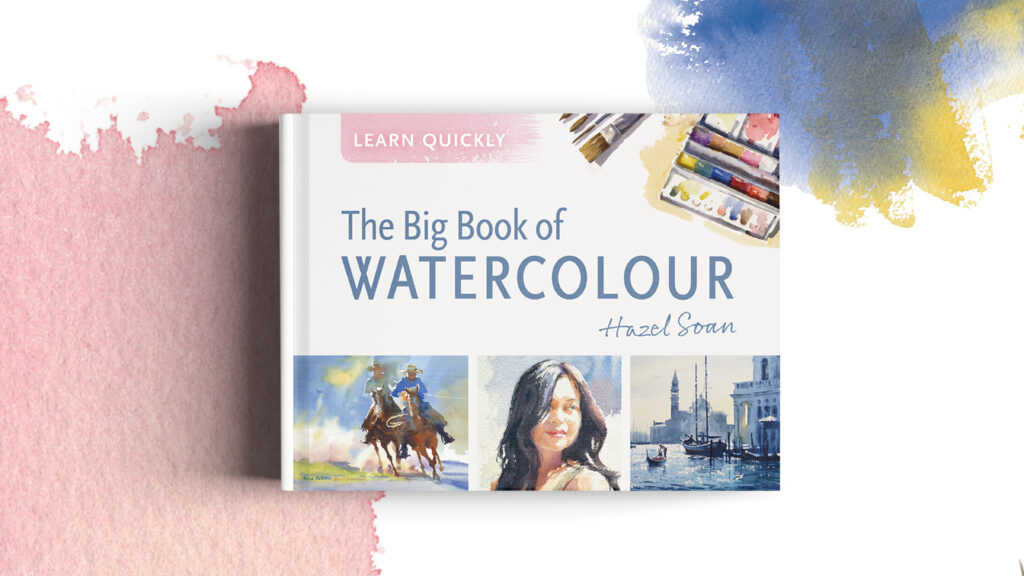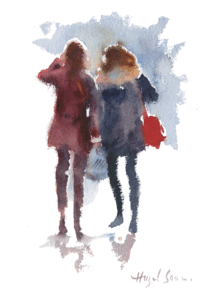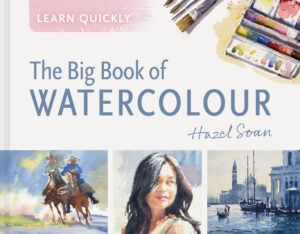Hazel Soan’s guide to watercolour

To celebrate the publication of her new book The Big Book of Watercolour, we’re sharing the award-winning artist Hazel Soan’s top painting techniques for painting in the medium of watercolor.
By Hazel Soan.
Wet on dry
In this technique, the wet paint is applied to dry paper, giving a crisp edge to the laid brushstroke. When dry, subsequent layers of transparent colour can be added on top in a series of overlapping tints and glazes. Because watercolour is a transparent medium, this layering of colours creates a whole variety of new colours and tones from just a few pigments. To avoid disturbing the drying particles of pigment underneath, each layer of paint must be allowed to dry completely before the next is added.
Wet into wet
In this technique the paint is applied to paper that has been either dampened with clean water or is damp from a previous, still-wet wash or brushmark. Paint is introduced with a gentle stroke and spreads out into the damp surface or wash, giving soft edges to the brushmark and
creating gradual blends where wet colours mingle with each other. Successive applications of paint must each be more concentrated than the last to take into account that there is already water on the paper from the previous wash. The drier the colour, the less it will spread.
Mixing by layering
The colours created by layering vary according to the order in which the colours are laid. Even from the same two colours, the result will differ depending on which colour is put down first. Since each mix is unlikely to be exactly the same as the one before, these differing tones add to the endless variety you can achieve. Layering is used frequently in watercolour landscapes. The sky is painted first and is often
extended under the foreground features to provide an undertone, which encourages harmony in the painting and enhances the mood. Sky washes must be allowed to dry if a crisp skyline is required

Mixing on paper / blending on paper
With a wet-into-wet technique a touch of ambiguity is created as the colours blend together on the paper more freely than when they are applied with wet-on-dry brushstrokes.
Backruns
If the mix of paint in the added brushstroke is too wet, the water will flow into the previous wash and cause a backrun, a mark that resembles a cauliflower! Watery paint that pools in a wash can be sucked up with the tip of the brush. However, don’t be afraid of backruns: they are one of the lovely characteristics of watercolour and although they may happen by mistake, they can also be used purposefully.
Dry-brush
The neat paint applied by a dry brushstroke provides a certain energy, as the action of the stroke is visible. The paint is not always concentrated – sometimes the brush is just barely loaded with paint and brushed sideways across the surface of the paper to create an uneven wash or brushstroke.
Splaying hairs
Pinching the hairs of the brush between your fingers and splaying them apart makes each hair deliver its load of paint in a single strand. You can use this method to make a series of fine.
More about The Big Book of Watercolor.
A compilation of practical guidance on everything you need to know about painting people and landscapes in watercolour, with simple exercises and step-by-step demonstrations to develop your masterpiece.
Hazel Soan is a hugely successful painter and an outstanding teacher and author of art books, which have introduced the wonders of art to a generation of amateur artists. Here she collates her vast knowledge on painting in watercolour in easily digested steps that can be achieved in short bursts of time. Available to purchase here as well as from all good booksellers.


